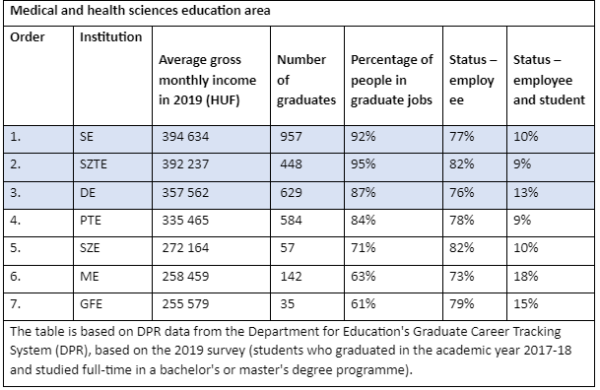This article was published in the UNI 2022 summer edition.
Bachelor’s degree courses
Unbranched Master’s degree
In the field of medicine and health sciences, there are 5 bachelor’s degrees and 3 master’s degrees. The highest average monthly gross salary in terms of gross monthly income is in
however, it is important to note that these figures were compiled before the large-scale wage adjustment of state-employed doctors, and include data from both the public and the private sectors. Depending on their field of study, those interested in a particular field of training can choose between several higher education institutions, including those in the capital and in rural areas.

Average starting salary after graduation is taken as a ranking indicator.

The average gross monthly income of medical and health science graduates in the 2017/18 academic year (based on 2019 data) is close to HUF 364,000, but there are significant differences between institutions. In terms of full-time graduates alone, the highest salaries were for SE graduates, with a monthly gross salary of more than HUF 395,000. In terms of average monthly gross starting salary, SZTE is in second place with nearly HUF 392,000, while DE is in third place with HUF 358,000.
On average, 87% of graduates with a bachelor’s degree in a field of study start working within 2 months after graduation. 82% of graduates manage to find a graduate job, the highest rate among graduates from SE, SZTE and PTE.
Around 13% of graduates choose to continue their studies in employment after graduation, the highest rates in ME (18%), GFE (15) and DE (13).
The average gross monthly income of SE graduates is close to HUF 395,000, which puts the institution at the top of our education area rankings for the expected graduate salary after graduation. A little less than two months after graduation, graduates are employed and 92% of them are in graduate jobs. SE is the largest training institution in the field of medicine and health sciences (including also the number of graduates), with 957 graduates in 2017-18. On average, SE students complete their undergraduate studies in more than eight active semesters.
The average gross monthly income of graduates from SZTE is nearly HUF 392,000, which puts the university in second place in the ranking of education areas. After graduation, graduates are employed in a little less than two months and 95% of them are in graduate jobs. SZTE is among the larger institutions in the field of medicine and health sciences, with 448 graduates in the 2017-18 academic year. Out of the seven institutions in our ranking, SZTE students complete their undergraduate studies in the fewest number of active semesters (8.1 semesters).
The average gross monthly income of DE graduates is nearly HUF 358 000, which puts the institution in third place in the ranking by education area. Graduates are employed within about two and a half months of graduation, and 87% of them are in graduate jobs. DE is also one of the larger training institutions in the field of medicine and health sciences, with 629 graduates in the 2017-18 academic year.
Only 4 % of graduates in basic medical and health sciences have studied abroad (e.g. under Erasmus) during their training. During training (before graduation), about half of the students had a professional job and almost 60% a nonprofessional one.
After graduation, around 26% of graduates settle and/or continue their studies in Budapest or County Pest. After completing their bachelor’s degree, they tend to find employment in the public sector (56% of graduates), 33% in the private sector and around 11% in non-profit or other employment. The proportion of graduates in the field of training who are in the labour market as employees is high (90%). Overall, graduates in the field of medicine and health sciences are satisfied with their work (87%).